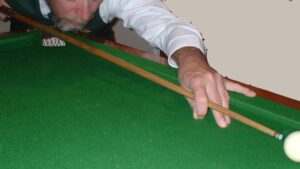Learn to Play Eight Ball Bridges and Rests
Learn to Play Eight Ball Bridges and Rests. The hand style be firm and unmoving until the shot is completed. The way a player puts his hand on the table is very revealing to an expert eye. One might liken it to a hand-shake when socialising. So often one sees the nervous uncertain player with a soft fidgety bridge hand and vice-like grip on the butt. Precisely the reverse is necessary for smooth relaxed play.
Much to my surprise, bridge hands seem to create many problems for players so that I feel it is worth showing them in some detail. It is the business end of the cue and plays as important a part as the other components in keeping the cue on line besides adding stability to the whole body. Learn to Play Eight Ball Bridges and Rests, The following photographs will convey more than words. So I will only comment briefly on the different bridges shown.
1) The normal bridge hand. The fingers should be evenly spread and the thumb should be well cocked to make a secure groove for the cue. It is important to keep the thumb fairly tight to the forefinger for smooth running especially for players with moist skin. A little experimenting will soon tell you just where to hold your thumb to ensure this.
2) The low bridge. Merely turn the hand over, lowering the forefinger, raising the little finger and applying pressure to it to keep the hand firm and strong. You will need a low bridge for shots requiring well below centre striking of the cue ball.
3) The looped bridge. This can be very useful when playing forcing shots or on many occasions when you feel your cue may escape in a tricky position. I find this especially useful when the cue ball is in that awkward spot off the cushion where there is not enough room for the hand to be placed. Always make sure your fingers are well braced with these bridges.
4) For playing alongside a cushion. The recommended bridge is extremely satisfactory when used correctly. Do not be satisfied with something that looks like it but does not do the job. Learn to Play Eight Ball Bridges and Rests, Remember, like stance these factors are important and must not be skipped over as not so important.
5) The most difficult cueing position, if that phrase need apply, is when tucked up tightly on the cushion. When this happens it is best to shorten your butt hold, slightly restrict your back-swing, and endeavour not to raise your head or move on the stroke. Learn to Play Eight Ball Bridges and Rests, This of course applies all the time but in this particular case you may find that all these things seem to be more difficult to control and this is caused by anxiety to perform the stroke with so little of the ball to strike.
When playing over the balls pay attention to your feet for balance, as you are not only generally stretched in body but also your fingers will be on their toes, if you see what I mean! Learn to Play Eight Ball Bridges and Rests. Badly positioned feet because body movement in this stroke resulting in the cue ball being struck in the wrong place and the shot will be missed. Place your left or forward foot a little wider than for normal shots so that the leg will have the strength to resist the push of the opposite shoulder which rises as does the cue butt for this type of shot.
Learn to Play Eight Ball Bridges and Rests 2
Introduction:
Eight ball is a popular and exciting game that requires skillful cue ball control and precise shot execution. To excel in this game, mastering the various bridges and rests is essential. In this article, we will explore the different types of bridges and rests used in eight ball and provide a comprehensive guide on how to improve your technique.
1. The Open Bridge:

The open bridge is the most commonly used bridge in eight ball. It involves placing your hand on the table with your fingers spread apart, creating a stable platform for the cue. This bridge allows for a smooth and controlled stroke, providing accuracy and power to your shots. Practice maintaining a relaxed grip and a consistent bridge height to enhance your open bridge technique. Learn to Play Eight Ball Bridges and Rests.
2. The Closed Bridge:
The closed bridge is another popular technique used in eight ball. It involves placing your thumb on the table, forming a loop with your index finger, and resting the cue on the base of your thumb. Learn to Play Eight Ball Bridges and Rests, This bridge offers stability and precision, especially for shots that require finesse and delicate control. Experiment with different finger placements to find the most comfortable and effective closed bridge for your game.
3. The Rail Bridge:
The rail bridge is employed when the cue ball is close to the cushion or rail. In this technique, you rest the cue on the rail, using it as a support for your bridge hand. The rail bridge provides stability and helps maintain a consistent stroke when playing shots near the cushion. Practice positioning your hand comfortably on the rail while keeping your bridge hand steady for improved rail bridge execution. Learn to Play Eight Ball Bridges and Rests.
4. The Mechanical Bridge:
The mechanical bridge, also known as the “rest,” is used when the cue ball is out of reach or obstructed by other balls. It consists of a cue extension attached to a bridge head, allowing you to reach shots that would otherwise be challenging. Familiarize yourself with the different types of mechanical bridges, such as the spider, swan, or rake, and practice using them to develop your accuracy and control in difficult situations.
5. Practice and Consistency:

Improving your bridges and rests in eight ball requires practice and consistency. Dedicate time to honing your technique, focusing on maintaining a stable bridge, a relaxed grip, and a smooth stroke. Learn to Play Eight Ball Bridges and Rests, Experiment with different bridge styles and find what works best for you. Regular practice will help build muscle memory and enhance your overall cue ball control.
Conclusion:
Mastering the bridges and rests in eight ball is crucial for achieving precision and control in your shots. By understanding and practicing the open bridge, closed bridge, rail bridge, and mechanical bridge techniques, you can elevate your game to new heights. Learn to Play Eight Ball Bridges and Rests, Remember, consistency and practice are key to improving your skills. So, grab your cue, set up some shots, and start perfecting your eight ball bridges and rests today!
More details are available here Accreditation and the AEBF is the National Sporting Organisation for EightBall Development.
Learn to Play Eight Ball Bridges and Rests